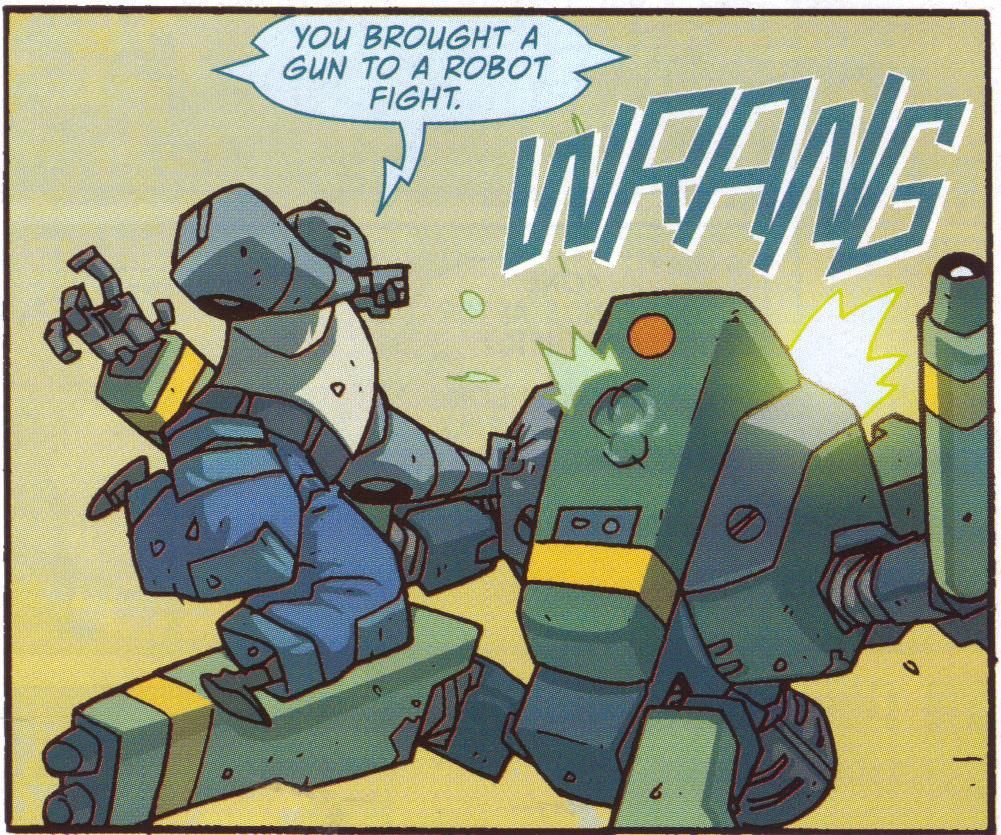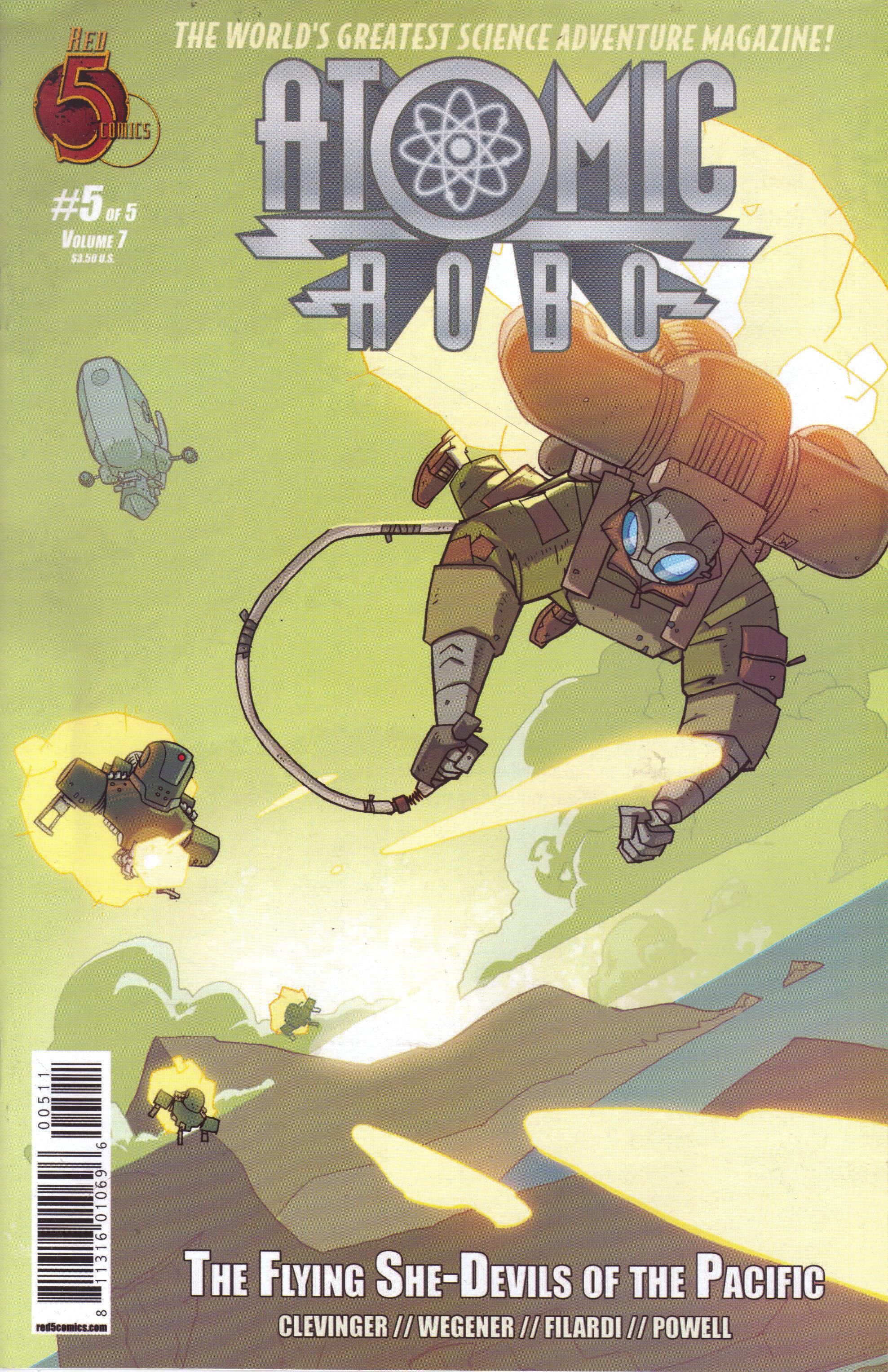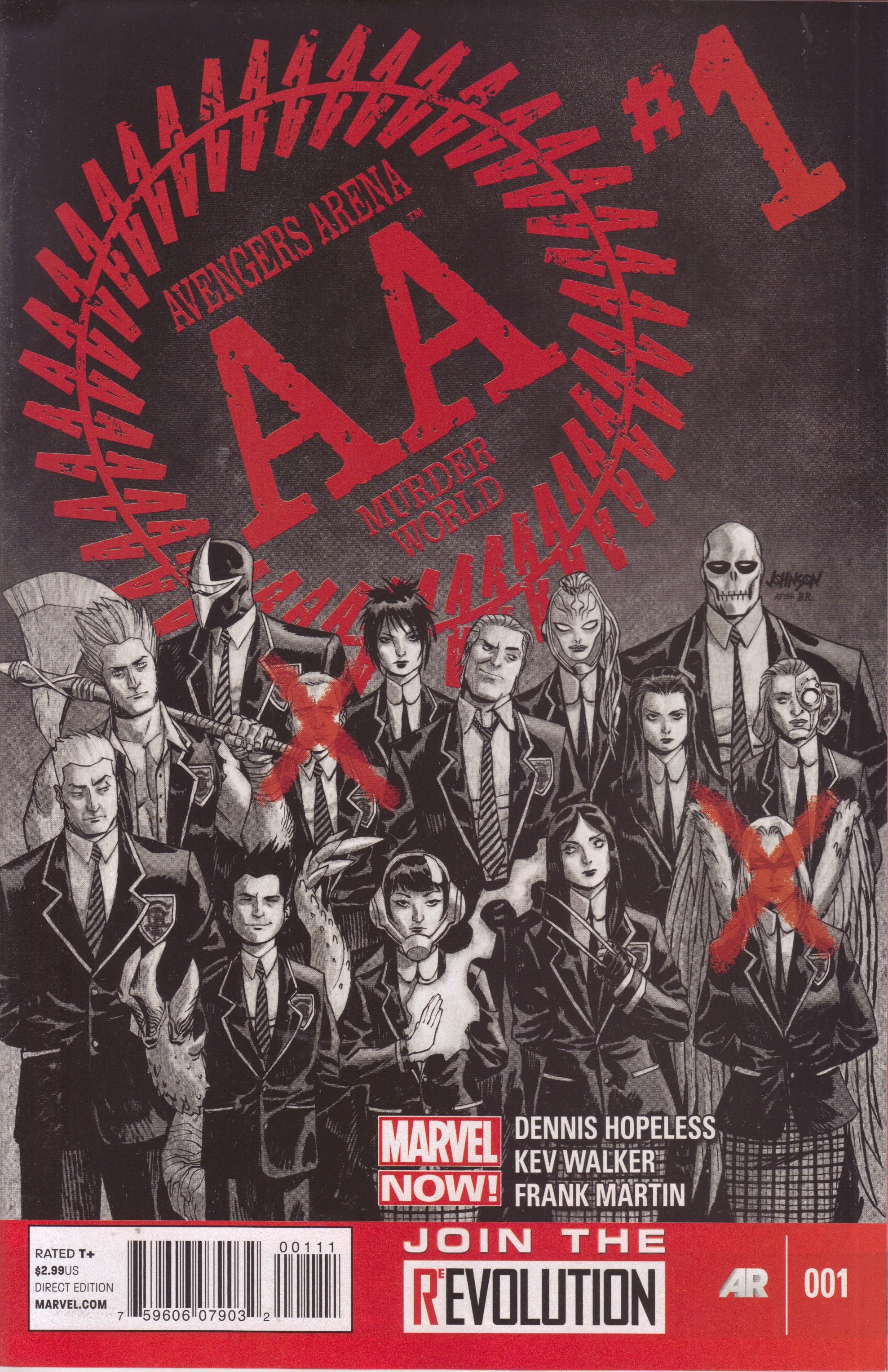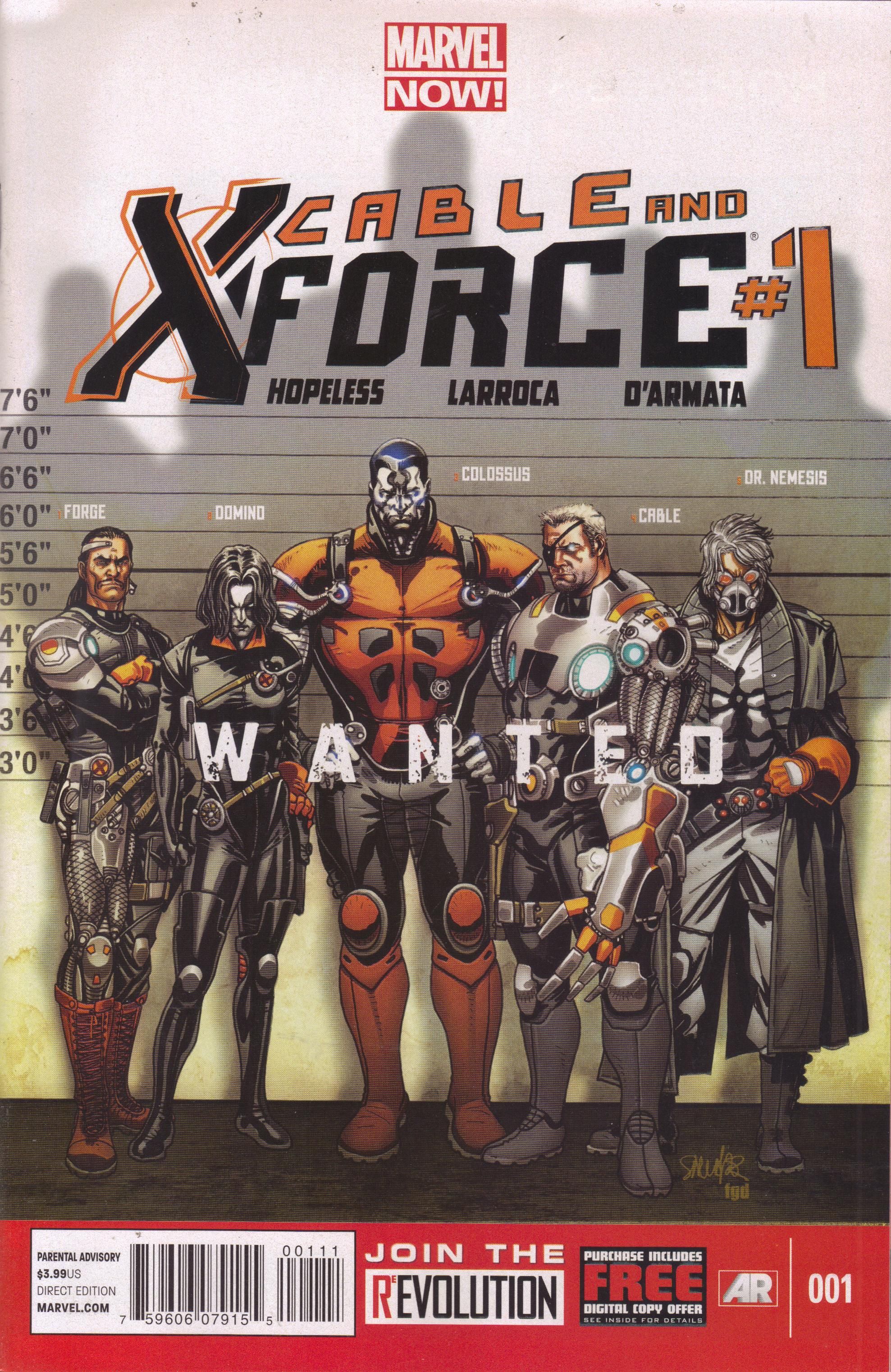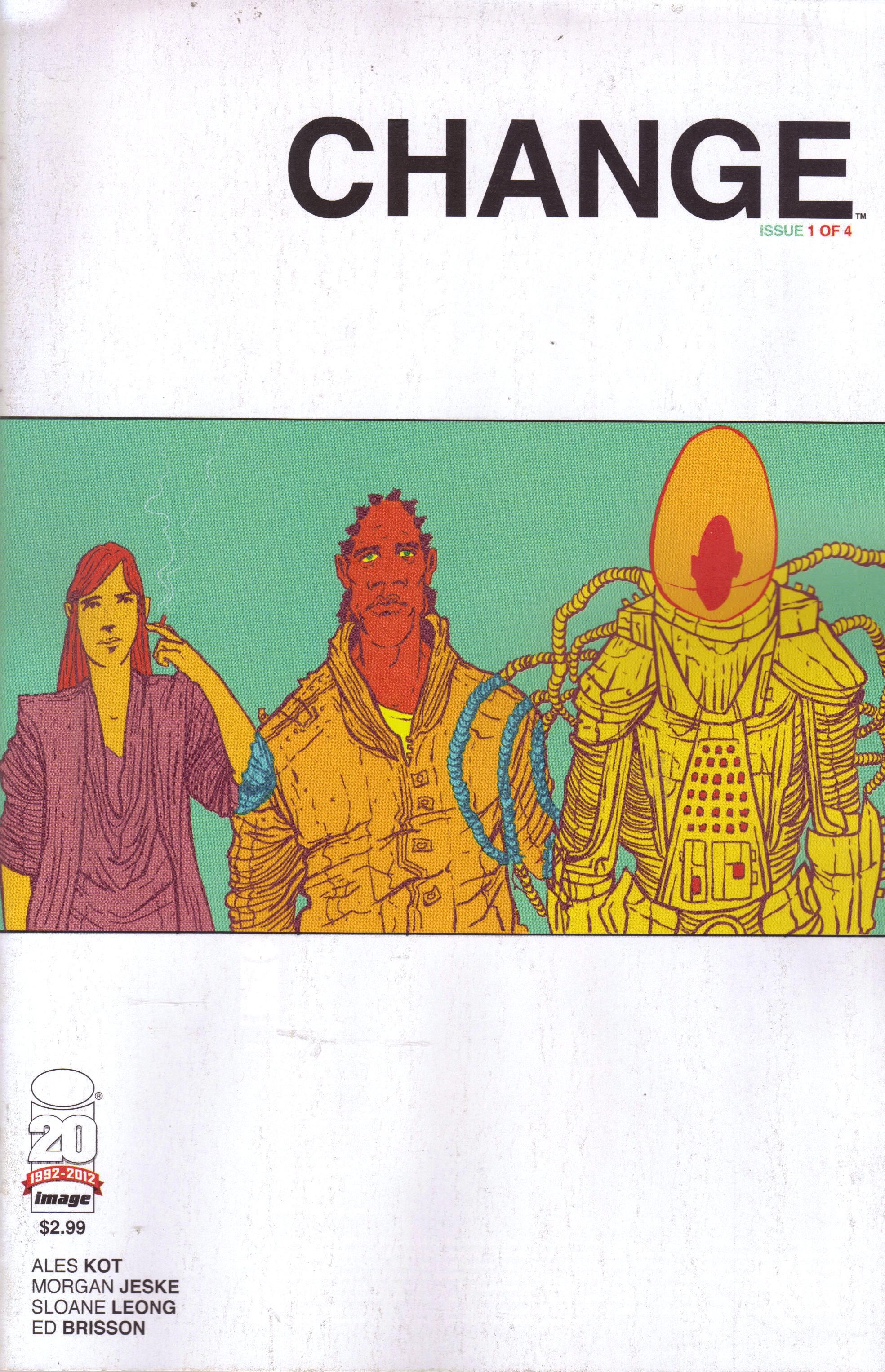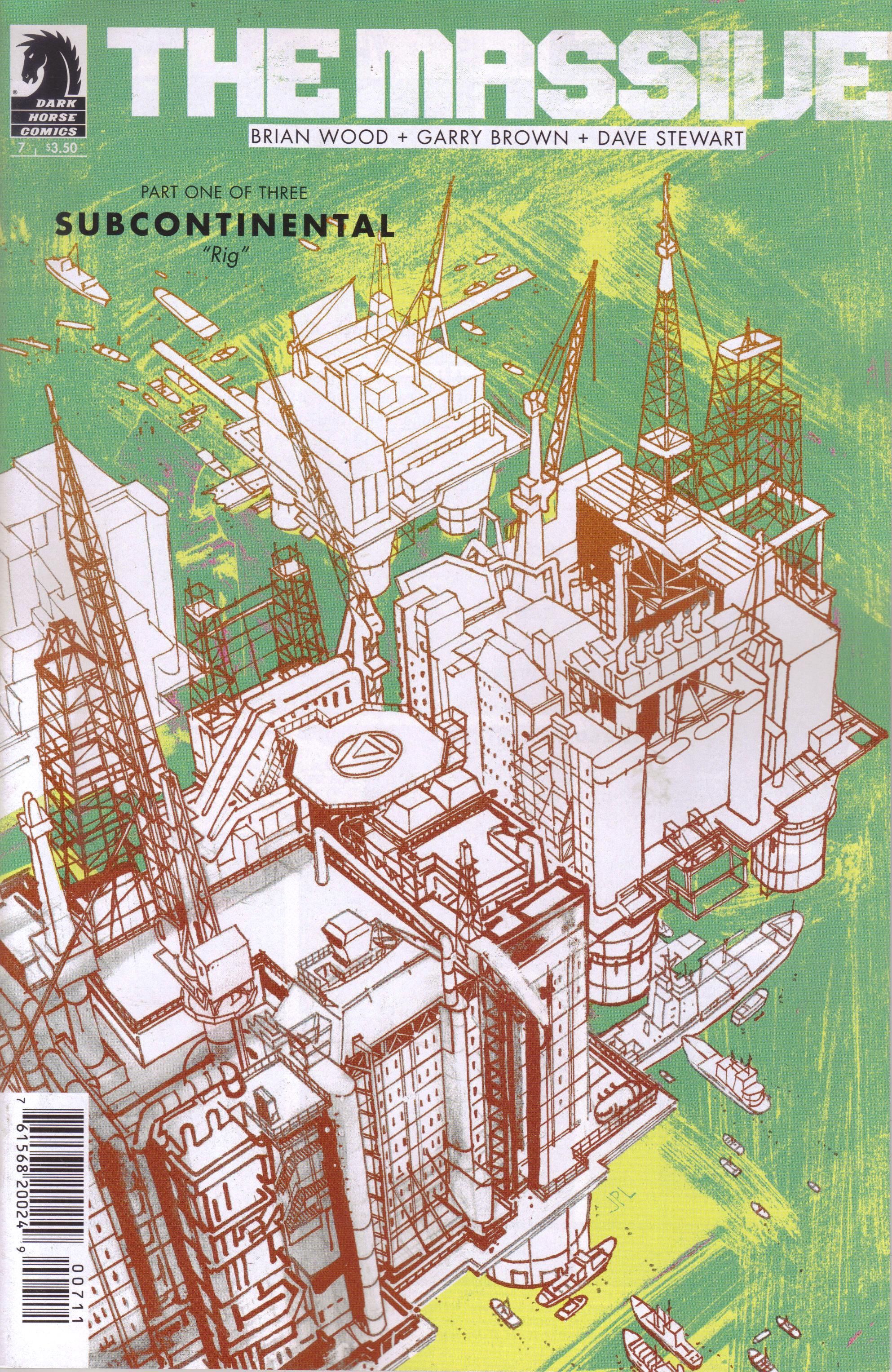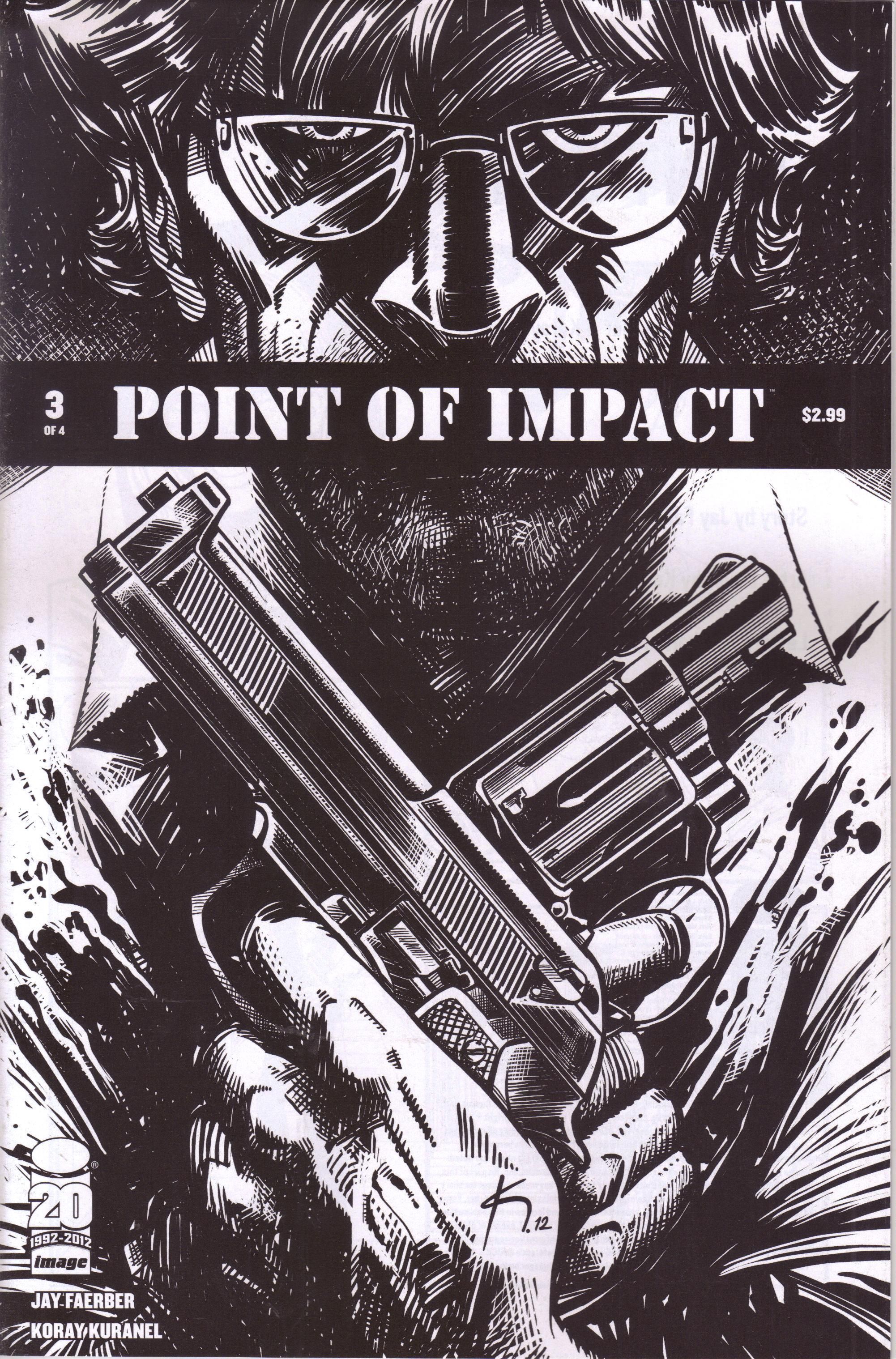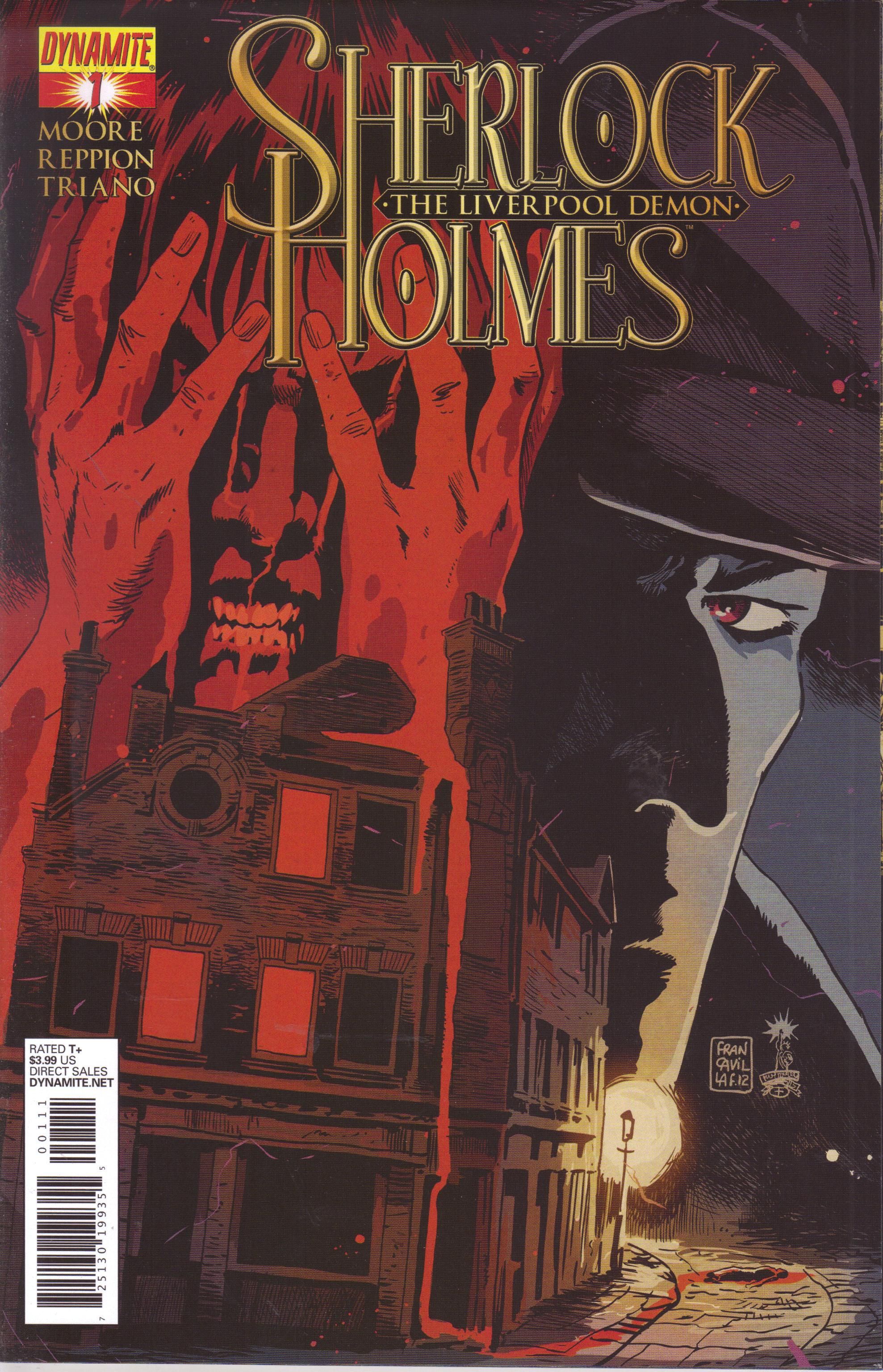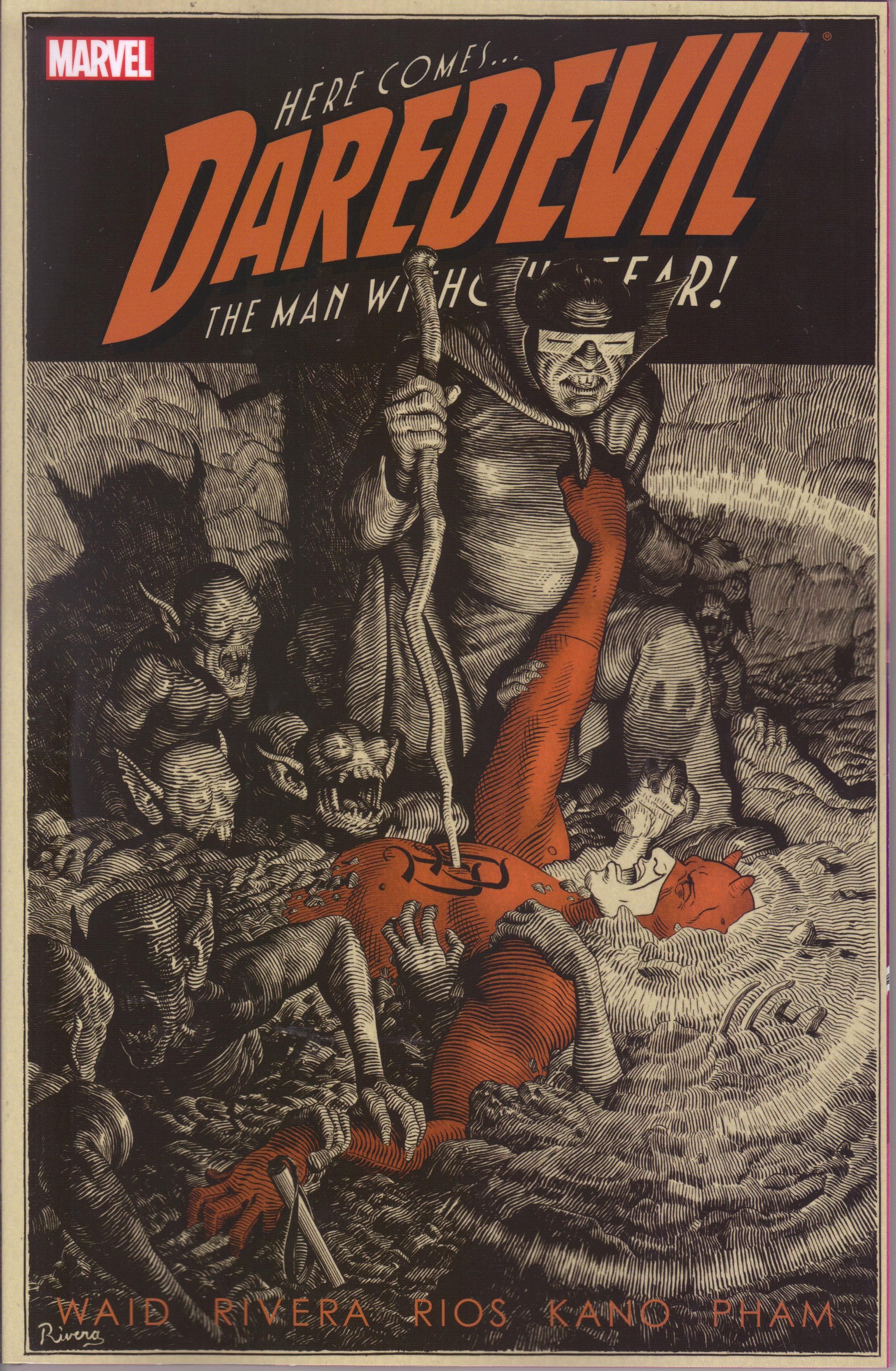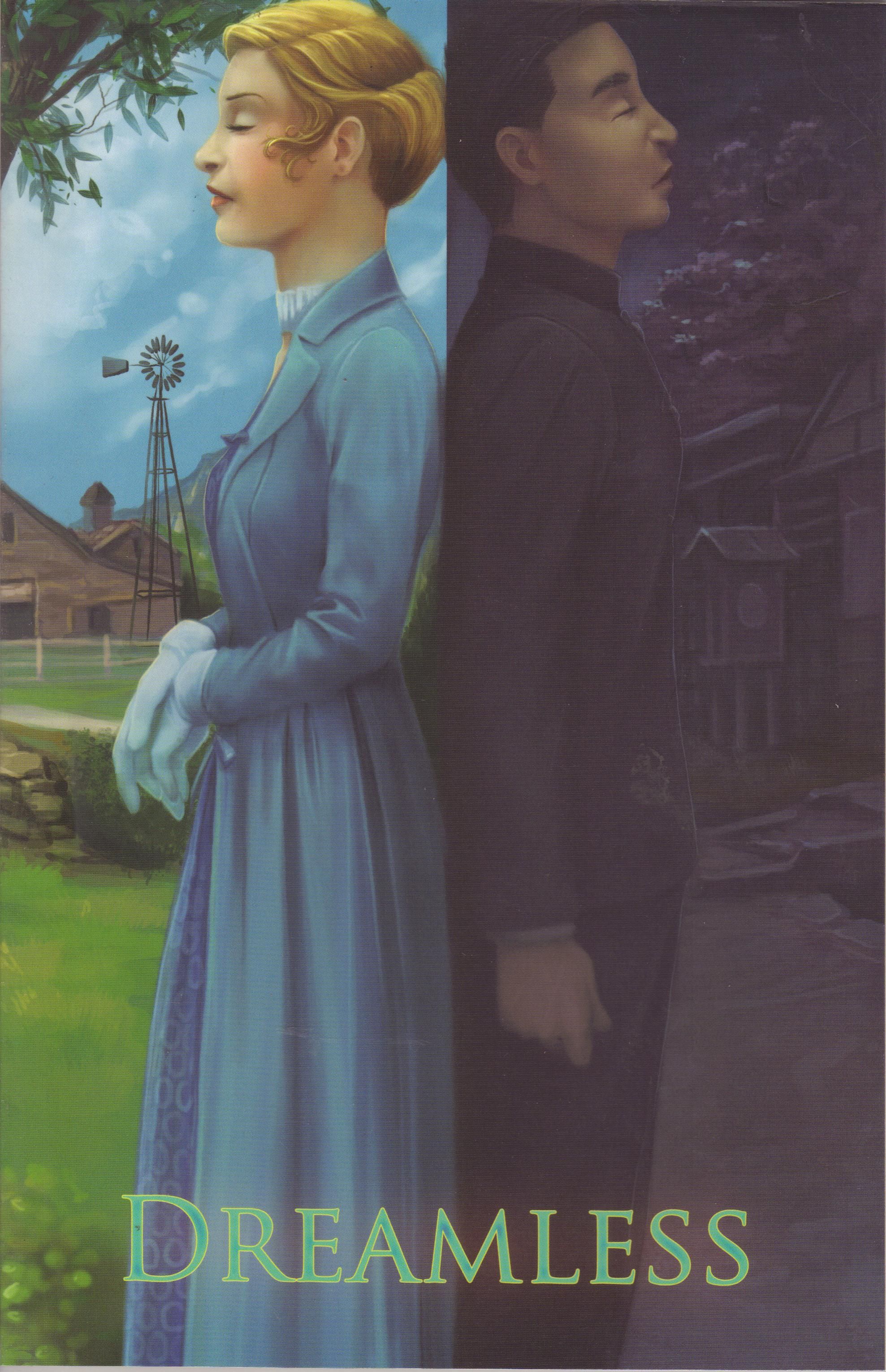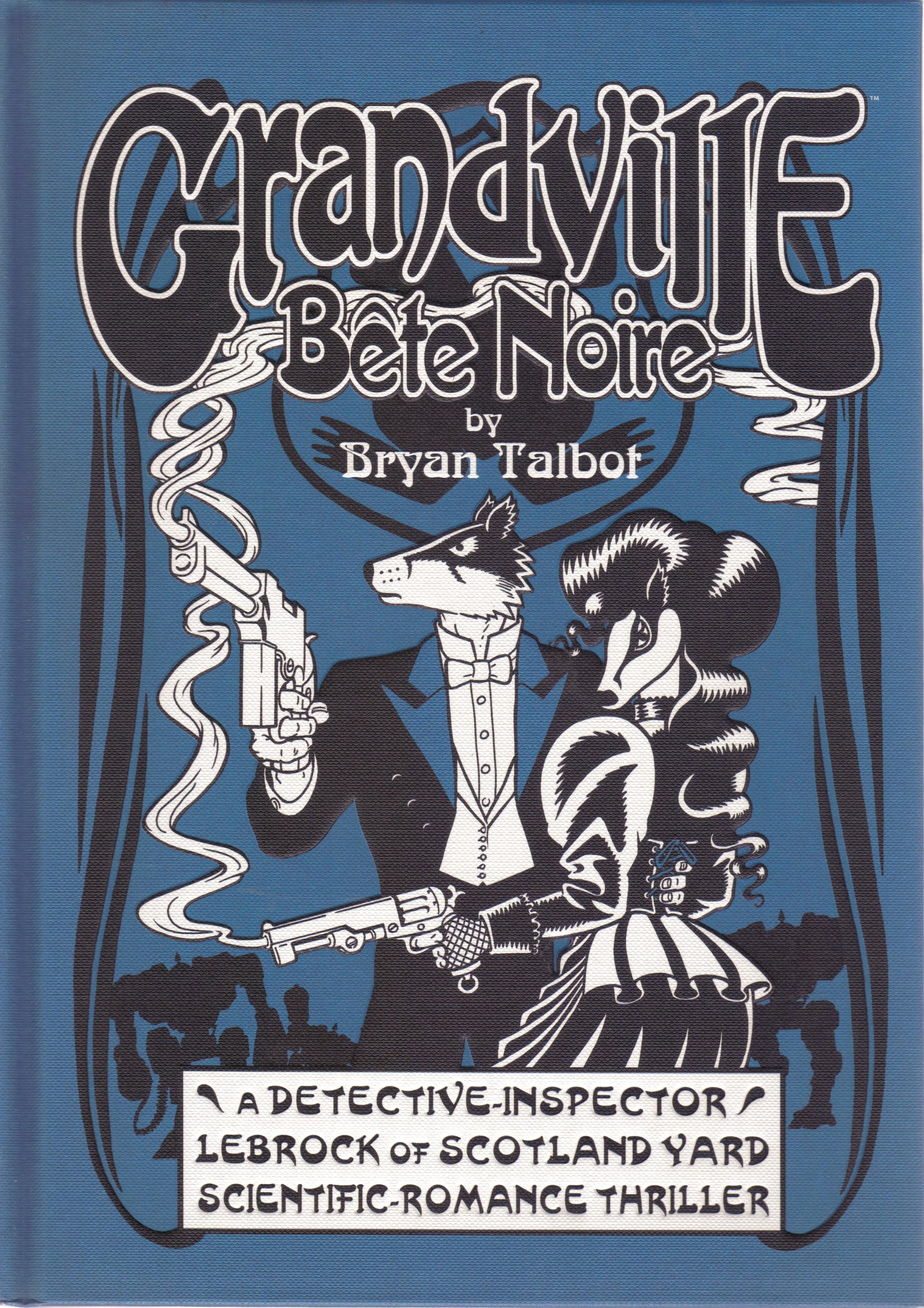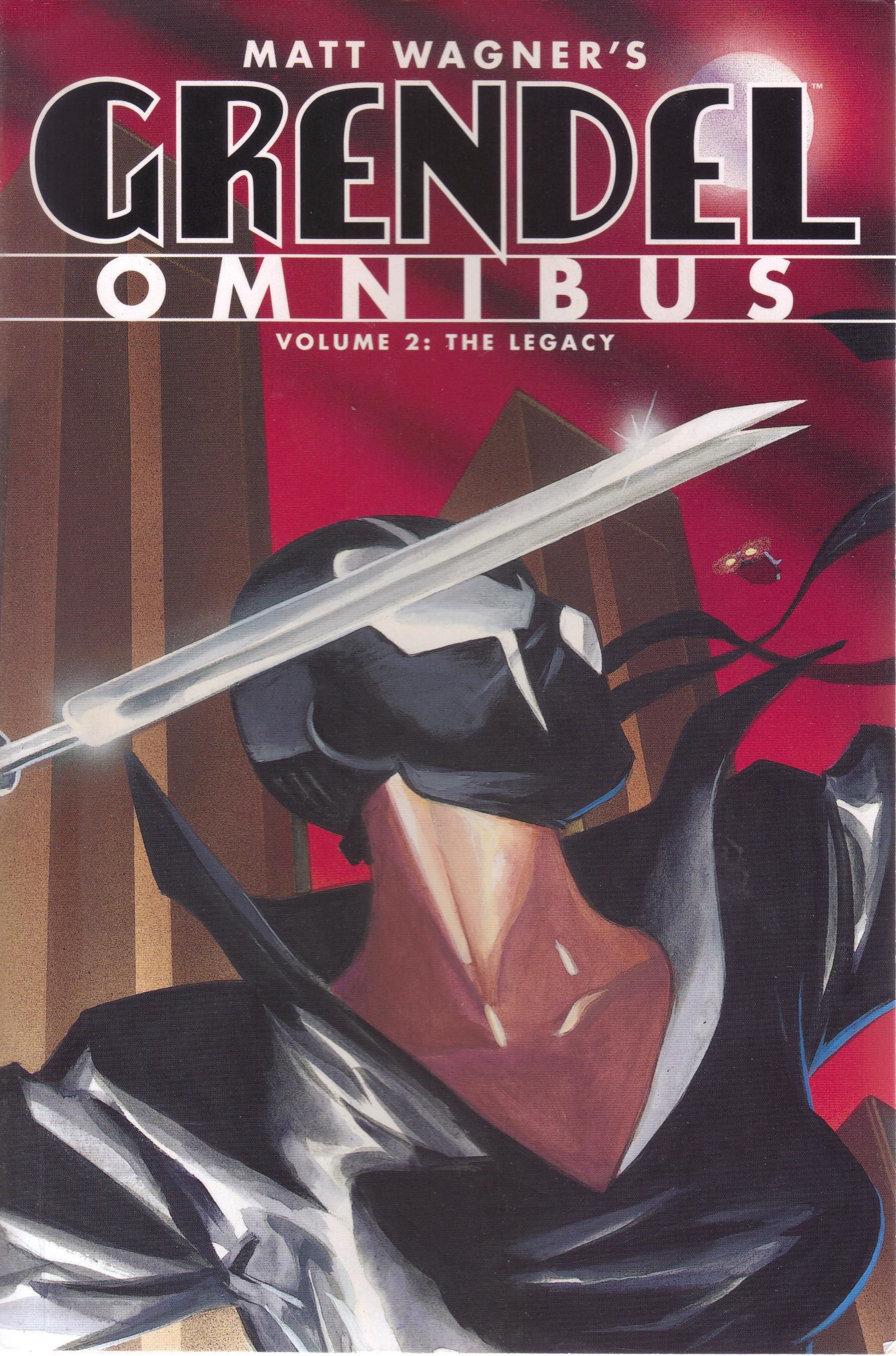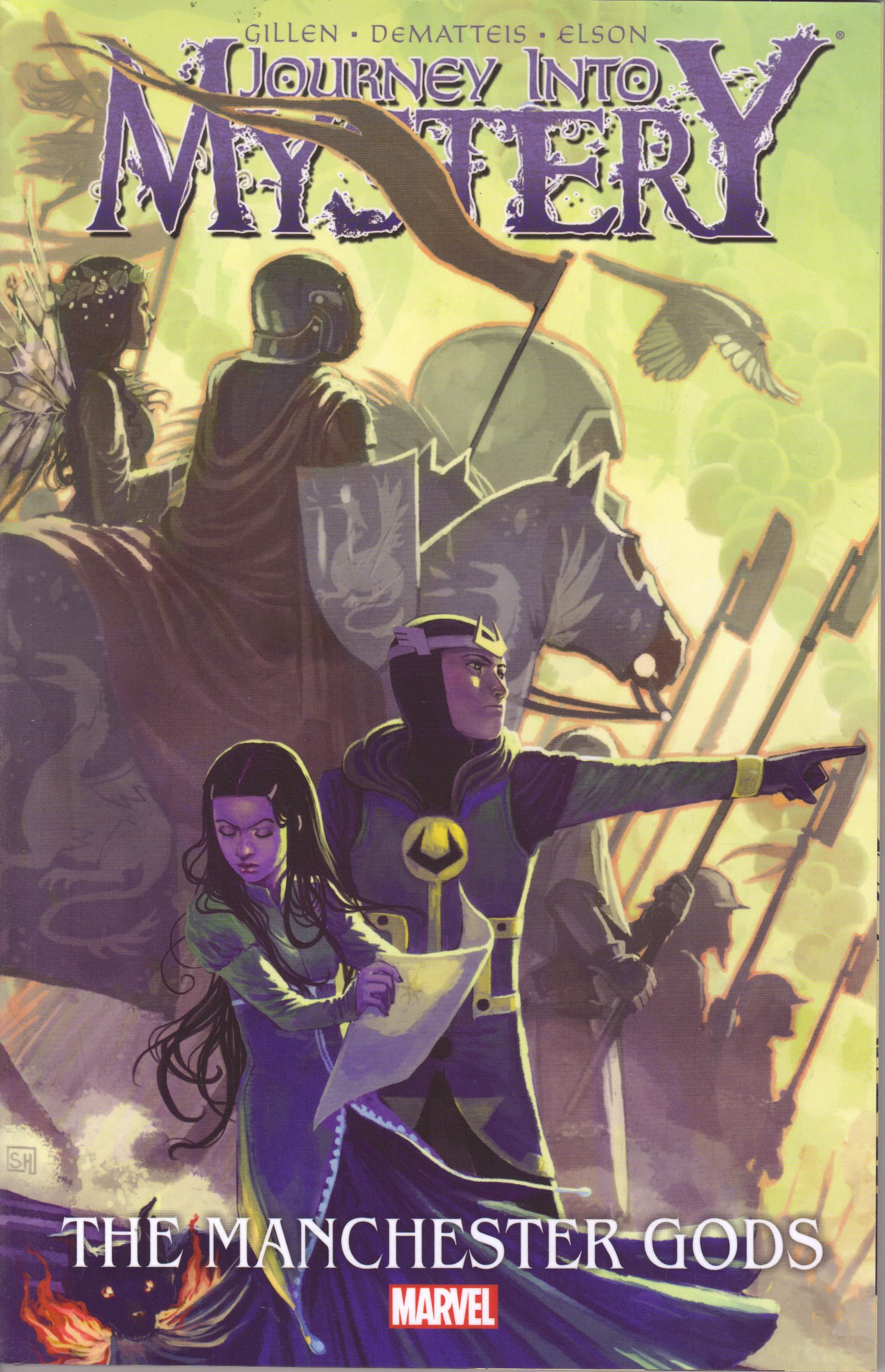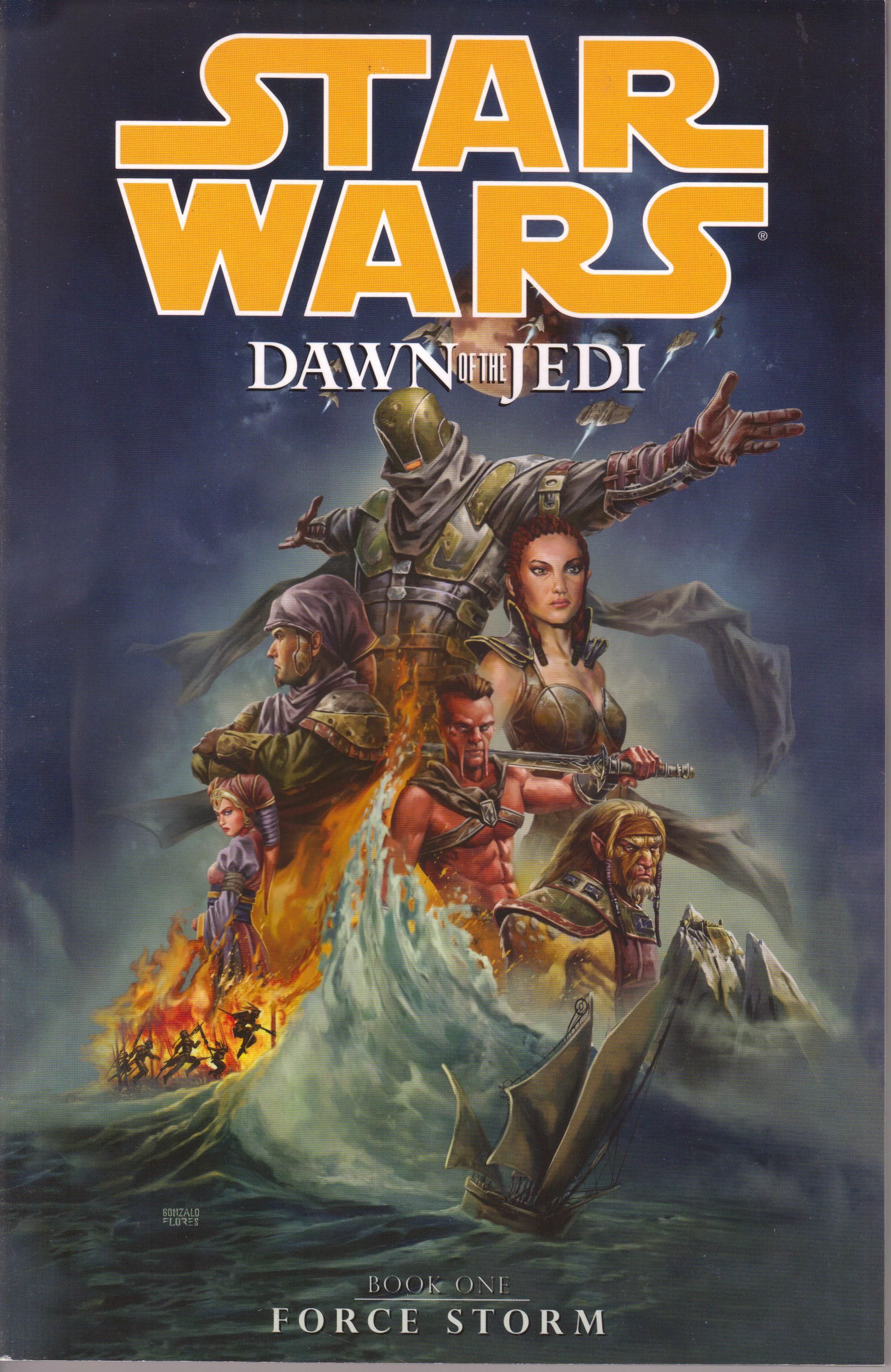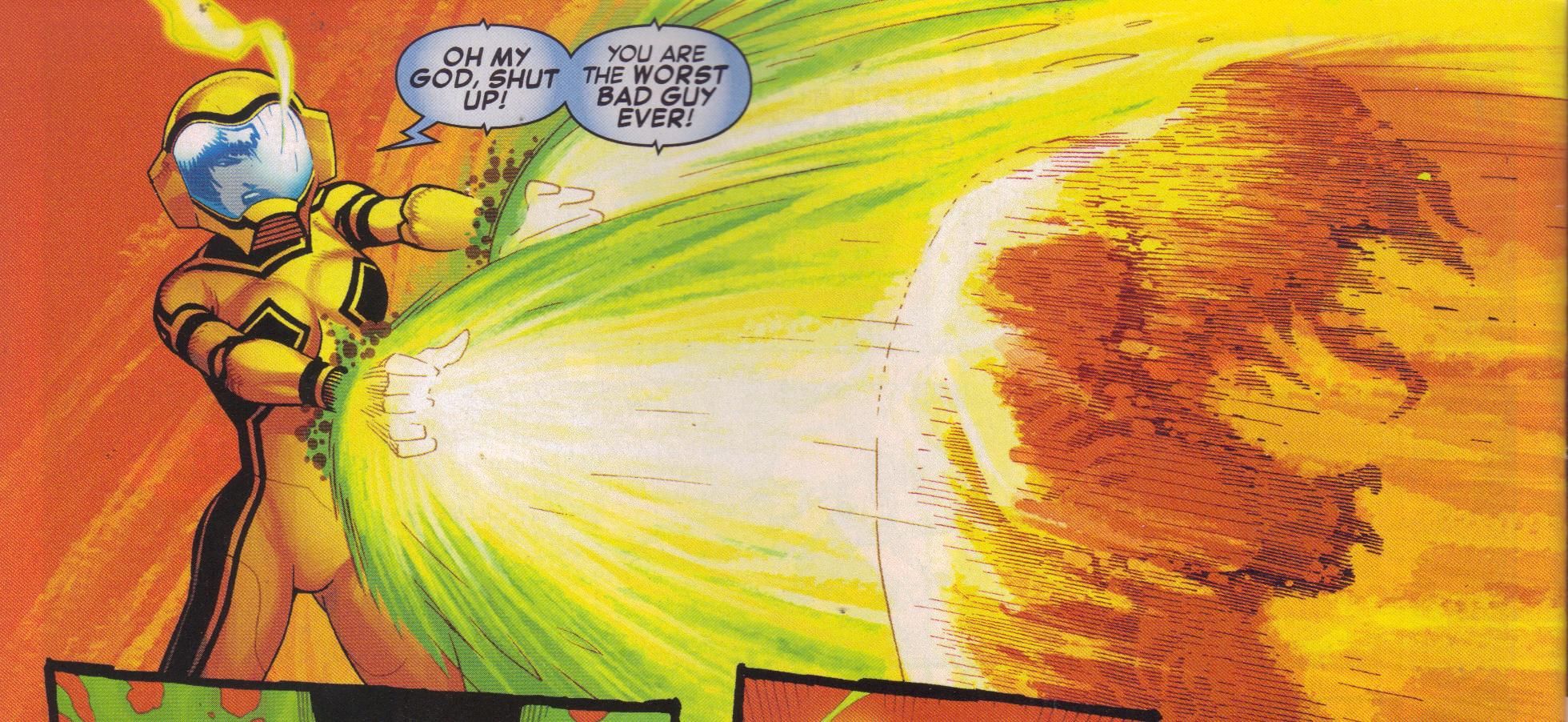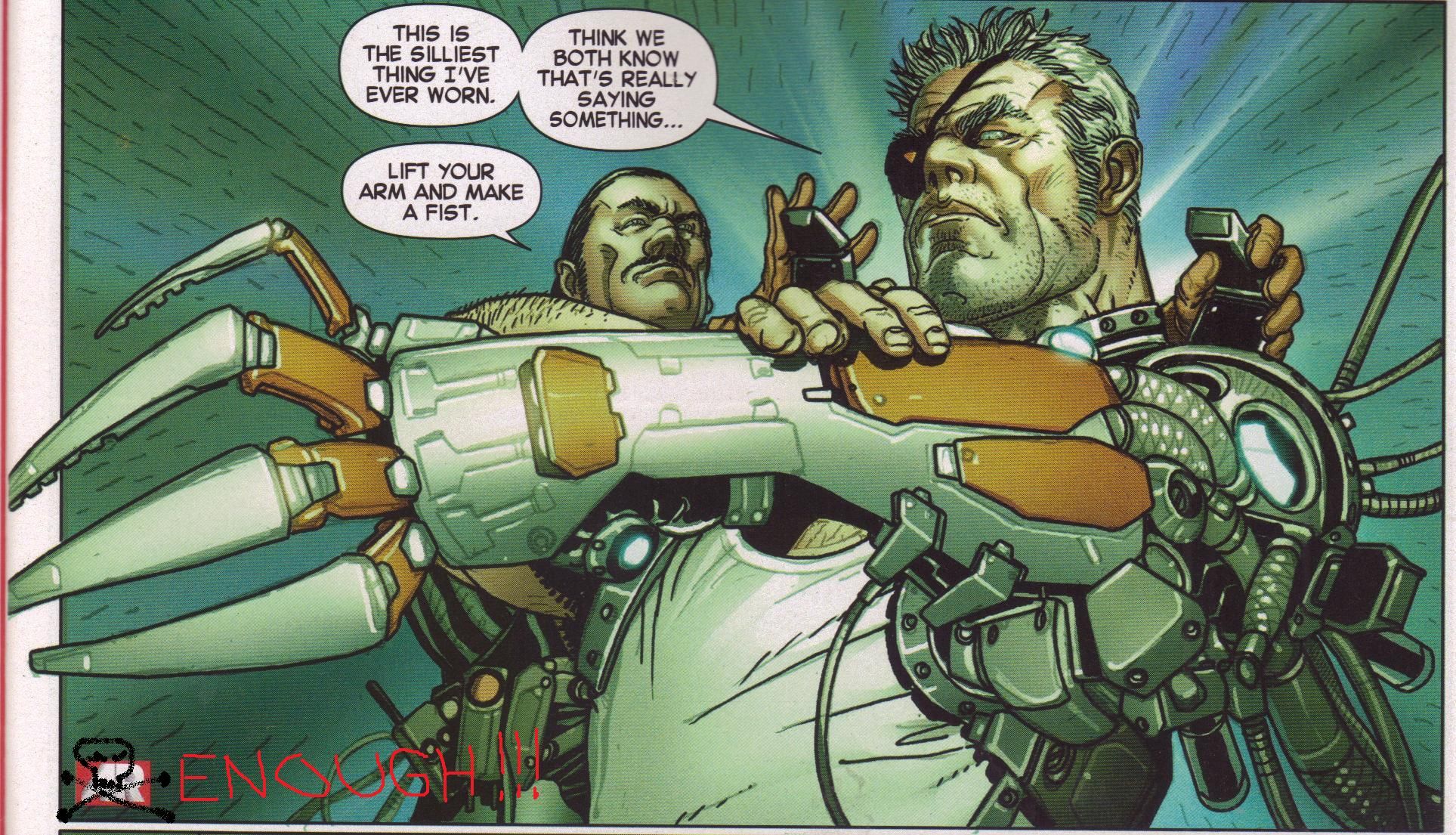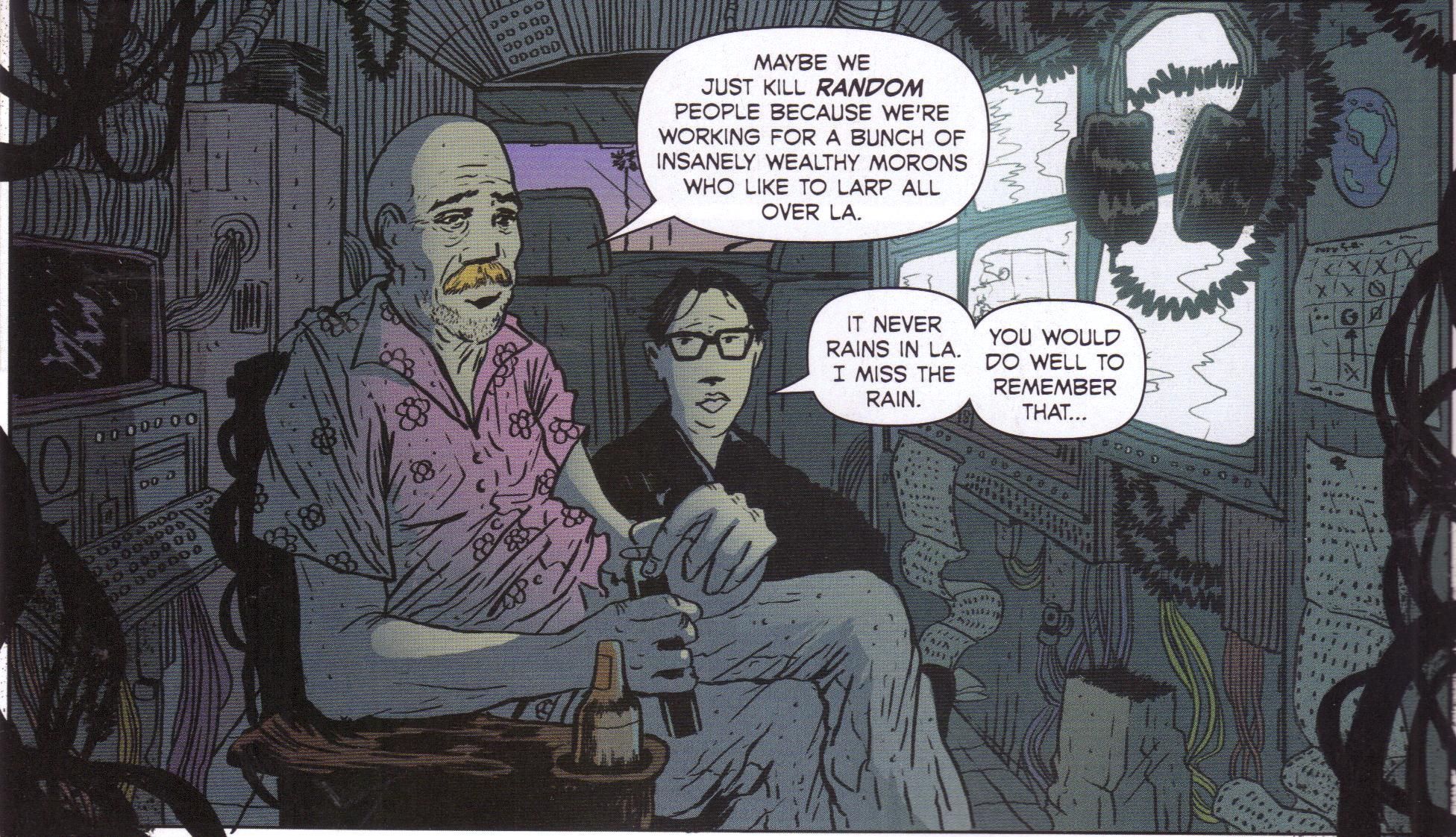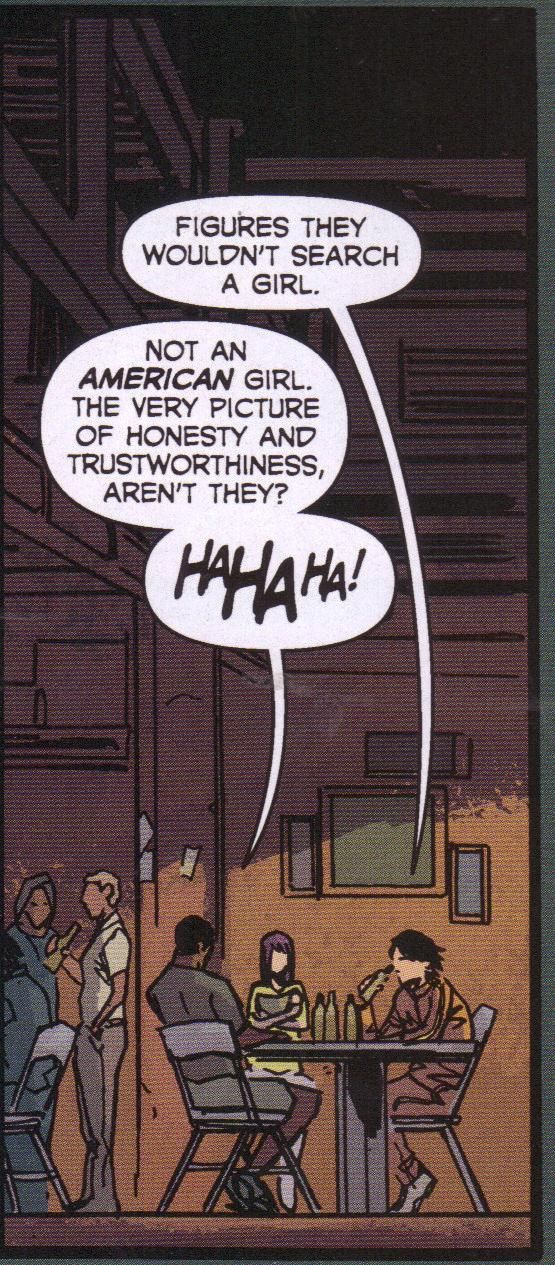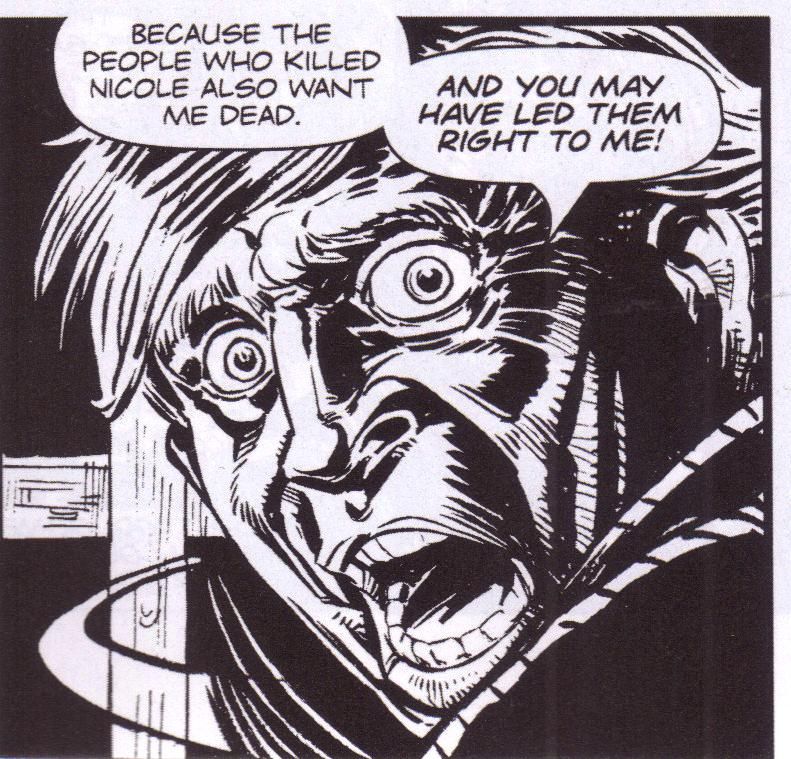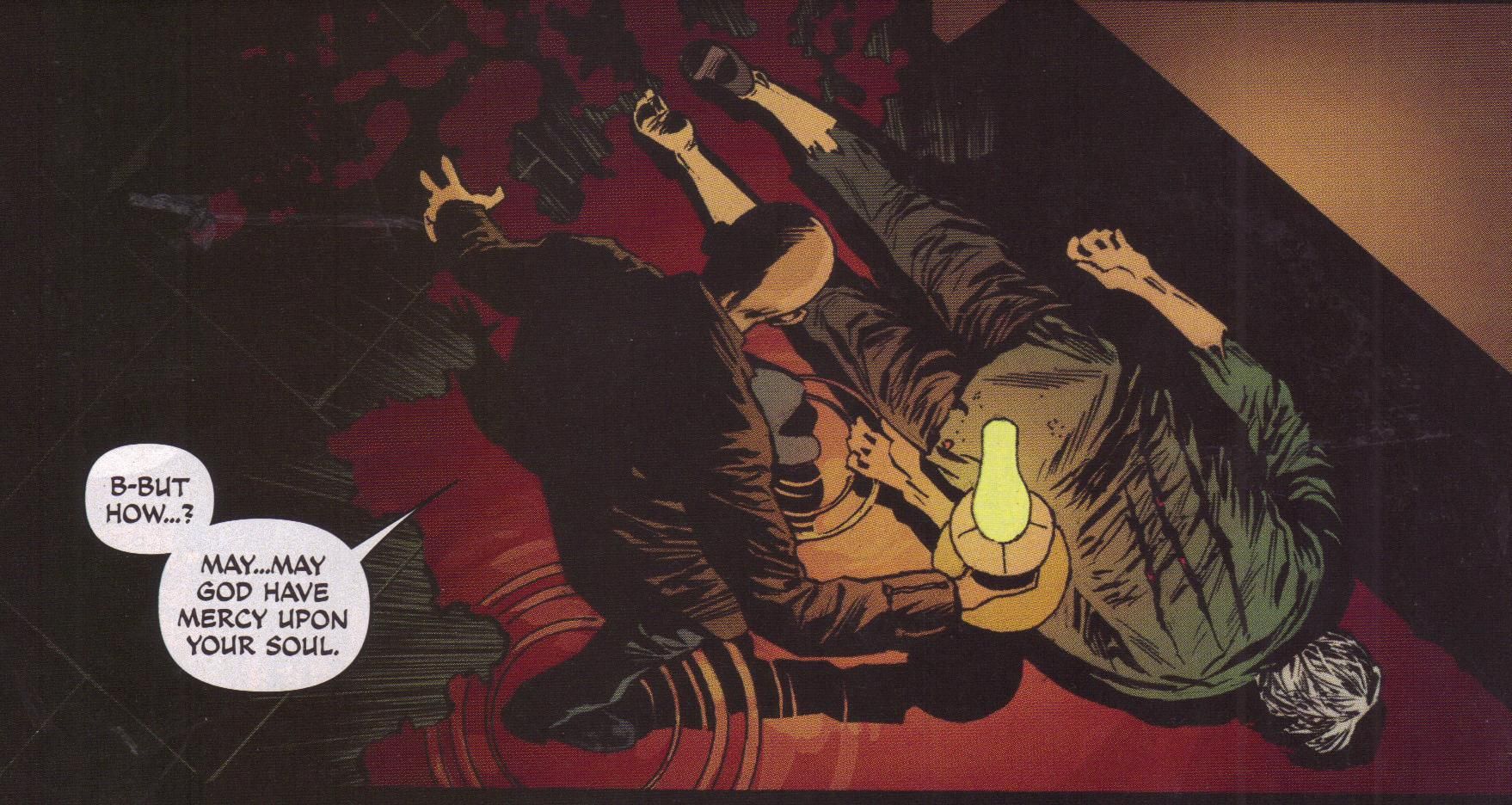Indeed, the Republican Right, while it worries plausibly about the loss of traditional values in an era of peace, is an example of the deformities it decries, since historically prosperous societies which perceive no outside threat have been the only ones that have the luxury to preoccupy themselves with discussions about such things as sexual values. The problem, though, is that we have no such luxury. The peace we think we have is only an interregnum before another cycle of conflict. The narcissistic isolationism of the congressional Republicans - who call for enforcing democracy abroad while denying the State Department the tools it requires for our own security interests and who refuse to pay our U.N. dues - comes at a time when the world vaguely resembles what it was before the outbreak of World War I. (Robert Kaplan, from The Coming Anarchy)
Atomic Robo and the Flying She-Devils of the Pacific #5 (of 5) by Brian Clevinger (writer), Scott Wegener (artist), Nick Filardi (colorist), and Jeff Powell (letterer). $3.50, 22 pgs, FC, Red 5 Comics.
"Flying She-Devils of the Pacific" is probably the weakest Atomic Robo mini-series yet, and I hope it doesn't bode ill for the series as a whole, because that would suck. Of course, it's not a bad comic by any means, but when we compare it to the others (volume 2, I think, was the weakest so far, and it recovered from that), it's too bad. Our pal Caanan made a good point when issue #4 came, as he mentioned that because we know everything will work out (the book is set in the past, after all), the characters need to be really strong, and the Flying She-Devils just ... aren't. This is a typical action movie ending in this issue, which means not everyone makes it out alive, but I didn't care enough about the characters to care that some of them died. It's well done, certainly, but it's like Clevinger had an interesting idea about women living in the Pacific right after the war, fighting bad guys like they're in some Milt Caniff comic, but he didn't really think it through well enough. I mean, the idea of the Flying She-Devils is pretty cool, but if that's all it is, perhaps it should have stayed in the drawer until Clevinger could hang a better story on it. That sounds harsh, but one of the cool things about Atomic Robo is that the plots are usually fairly intricate and exciting and full of interesting character interaction. The plot of this series was very straightforward and Robo's interaction with the characters wasn't as good as it has been, so all we're left with is an exciting story. That makes this a pleasant enough read, but it's fairly forgettable. Too bad.
I'm also still not convinced that Nick Filardi is the best colorist for Scott Wegener, and I'm missing Ronda Pattison more every issue. I just don't think Filardi's soft coloring goes well with Wegener's hard etched lines. But that's just me.
It's not like I hated the mini-series, and I did enjoy the first few issues. But then Clevinger locked into "action movie" mode, and it became less interesting. I imagine that the creators have more Robo stories in their portfolio, and I'll definitely be there for them. I hope they can regain the magic!
Rating: ★ ★ ★ ★ ★ ★ ☆ ☆ ☆ ☆
One totally Airwolf panel:
Avengers Arena #1 ("Worse Things") by Dennis Hopeless (writer), Kev Walker (artist), Frank Martin (colorist), and Joe Caramagna (letterer). $2.99, 20 pgs, FC, Marvel NOW!
It's DENNIS HOPELESS WEEK at the Marvel NOW! compound, as the two new Marvel launches are both written by Hopeless (Dark Avengers sort of reboots, but I'm not counting that as a Marvel NOW! book, because they're my rules WAAAAAHHHH!), with this being the first and by a pretty far margin, the superior one. So let's dive right in!
There are two (2) ways to review this comic, and I will review them both ways. That's why you love me! I think you have to decide going in what kind of reader you want to be, because if you read it one way, the book doesn't really work, but if you read it the other way, it's pretty good. So, let's get to it.
Review Number One:
You can read this as a Marvel comic set in the regular Marvel Universe. If you do that, the book doesn't really work, does it? I mean, it could in the long run, but this first issue is really awkward. It begins viscerally, with Hazmat and X-23 going at it in brutal fashion, gorgeously illustrated by Walker, who absolutely kills on this issue. It's "Day 29," and Hazmat is narrating. It looks like they're both in really bad shape, but before we can find out what happens, Hopeless flashes back to "Day 1." Hazmat and Mettle are in bed together (did anyone notice that Hopeless made sure that Jennifer is 18 in her mini-bio so she can get freaky with Ken and nobody can claim anything icky is going on?) when they're blipped out of bed and, along with a bunch of other random young Marvel heroes, taken to the Savage Land, where Arcade tells them they need to kill each other to survive, and in 30 days, only one of them will be left. Hopeless makes sure that Arcade tells them that he got the idea "from a couple of kids' books" he read in prison, which is a nice way of acknowledging that, yes, Marvel is ripping off Battle Royale and The Hunger Games. The kids attack Arcade, but he proves remarkably resilient, and then he decides to kick things off by killing one of them. So he does. Dang.
Okay, so here's why this doesn't work in the Marvel Universe. I have a soft spot for Arcade, but as he admits, he hasn't had a lot of success in his endeavors in killing heroes, but Hopeless seems to be trying to rectify that. But while this set-up is intriguing, if you've ever read a Marvel comic, you know a couple of things: Arcade is a hitman-for hire, and he has no powers. Hopeless, I trust, will address both of these things over the course of the series, but he doesn't appear to be doing this for any other reason that he's crazy ... which is a terrible motive for any villain. I guess he's become more and more crazy over the years, but still - that's a lame reason. More annoying to me was the fact that he does, in fact, seem like a god (as he states in the book). I hate the idea of simply making the villain have all sorts of powers that can defeat anyone just so we can see how bad-ass he is, and that's what we have here. If you read this without any knowledge of Arcade and you're just going from what he says in this issue, you're thinking, "Hey, wow, he's pretty powerful ... but what are his powers?" If you've read a comic with Arcade, you're saying, "Hey, wait a minute - Arcade can't do that shit!" Either way, it's a big ol' hole in the story. Arcade also tells the kids that nobody is coming to get them. This gets back to abilities that Arcade doesn't seem to possess, as how could he keep the superheroes of the Marvel Universe from finding him? I mean, seriously - he makes a joke about the Jean Grey School having better security than Avengers Academy, which is why those characters aren't in the book, but there are plenty of people who would be able to find these kids ... unless Hopeless is going to hit us with something revelatory about Arcade's powers. But it's still frustrating. Yes, I know that's the nature of serial storytelling, but when there's this big a change ... it's annoying.
The death of the character in this works only if you've read other Marvel comics, too. Hopeless, as most writers of DC and Marvel do, is relying on the work of other writers to build emotional content and hoping that we've read the right comics. In stories like this, where people are stuck in a small space and they get dispatched one by one, the first people to die are ciphers, there simply to establish the threat's bonafides. It doesn't mean anything, really, and we only start caring when the core group starts dying. But in this comic, because it's part of the greater Marvel Universe, Hopeless uses characters that someone cares about (presumably), but he does no heavy lifting with regard to making the characters interesting, so it's up to the reader to make the connections. Considering that these characters are from low-selling or cancelled comics, that's a tall order for the reader, but because Hopeless wants the deaths to mean something, he can't just destroy faceless characters - these characters actually have some history. If you were just reading this comic without having read the "right" other Marvel comics, I imagine this would be a frustrating read, because you know you're supposed to feel something, but without the foundation, it's hard to care about the character.
Which comes around to whether a gruesome death match in a universe where plenty of people already die and come back to life on a regular basis is a good idea. Obviously, Hopeless was given a "death list" of characters he could use (and, of course, he has at least one character - X-23 - who heals pretty quickly) - which is why the Jean Grey school was off-limits, I imagine - and he threw those characters in there. But that turns this into a rather ghoulish exercise, especially in a world where death means little. It's hard to get worked up about these characters' deaths, because they can just come back. I've mentioned a couple of places that I'm busy working on a post about Sandman (it's coming, I swear - it's just taking a long time!), and I always get really worked up about Carla's murder, because it's so senseless and downright cruel. There's no possibility that Carla is coming back to "life," so her death - the death of one of the most minor characters in the entire epic - bothers me a lot more than the one in this issue, which is of a character who has had a lot more development. Even if you've read the "right" comics and the death of this character means something to you, is it really that sad? I mean, this is Marvel - people come back from the death all the time! Even obscure characters like this one! I have become much more an advocate of nobody dying in superhero comics over the past few years, not because I'm going soft, but because it's usually just done for shock value and it's absolutely meaningless. This book, then, becomes the most meaningless, because its only purpose is to cull the herd. Really, Marvel?
Finally, the culling the herd is, of course, of young and relatively new characters. Marvel has never cared about replacing their lucrative IPs, but this is one of the more cynical ways to announce that to the world. "Hey, fans!" Marvel says. "Don't worry - your favorite characters from 50 years ago aren't going anywhere. Look, we're killing off anyone who might conceivably replace them! Whoo-hoo!"
So, yeah. That's one way to read this.
Review Number Two:
On the other hand, you could read this not as a Marvel comic, but as something in a vacuum, and it's pretty good. It begins with two characters on the verge of killing each other, and then goes back and shows how we got there. There's a villain we know nothing about who seems to have every superpower known to man, and these kids are completely outclassed against him. There are two characters who have some nice interaction, but not enough to make us care about them too much, and then, in the tradition of such things, one character is killed spectacularly. In a closed environment, this is an intriguing prospect. No, we know nothing about the characters, but that's to be expected in a scenario like this. What we can figure out is that the characters will try to work together at first but then things will get a lot worse, leading to "Day 29," as we saw in the beginning. Walker's excellent artwork, combined with Martin's bright colors, make this a big, bombastic superhero comic in which people happen to do horrible things to each other. The opening sequence is a gripping fight, as Walker/Martin use computer effects well in one panel, and neither characters gives quarter as they battle. Walker captures Hazmat's fear and X-23's ferocity wonderfully, and the character's death is amazing (in a horrific way, sure, but still). If you absolutely ignore that this is taking place in the Marvel Universe, it's a pretty good first issue. There are the same questions about the villain - why is he doing this, how is he so powerful - but they're not as annoying if you don't have foreknowledge of Arcade.
I choose to read this as if it's not taking place in the Marvel Universe, because it makes no sense if you read it that way. So it's a good start. Much like Deadpool, I can't imagine this lasting longer than six issues with this concept, and unlike Deadpool, there's really nowhere to go after this, so shouldn't this be a mini-series?
Rating (Review One): ★ ★ ★ ★ ☆ ☆ ☆ ☆ ☆ ☆
Rating (Review Two): ★ ★ ★ ★ ★ ★ ★ ☆ ☆ ☆
One totally Airwolf panel:
Cable and X-Force #1 by Dennis Hopeless (writer), Salvador Larroca (artist), Frank D'Armata (colorist), and Joe Sabino (letterer). $3.99, 20 pgs, FC, Marvel NOW!
The second Hopeless Marvel NOW! book, however, gets no second review, because it's kind of dumb. Obviously, I'm going to think more highly of Avengers Arena because it's not drawn by Salvador Larroca and this one is, but even the writing on this book is kind of dull. We begin at some kind of indeterminate facility (with lots of pipes and vats!), where Cable, Colossus, Dr. Nemesis, and Domino happen to be. Unfortunately for them, there are a lot of dead bodies lying around, which doesn't look good when the Avengers who are quite uncanny also show up. Havok tries to get them to explain, but Cable just blasts his gun at them (he doesn't hit them, which should be a clue that he's not being a bad dude, but I'm sure they'll miss that) and they teleport away. Then we flashback (say this about Hopeless - in both books this week, he begins with a bang, which is not a bad way to begin a comic) to "days earlier" so we can catch up with what's going on. Hope is trying to fit into the public school system, Cable is gathering a team, and he's having some kind of weird dreams. Then, at the end, there's something horrible happening that is linked to his dreams and the "techno-organic virus" that is no longer infecting Cable but seems to be popping up elsewhere. You know how there are things in comics, especially in shared universes, that are so very, very stupid, but they never seem to go the fuck away? That's how I feel about the "techno-organic virus" in the X-books. I bet, if we had a time machine, Chris Claremont and Bill Sienkiewicz would go back in time and shoot their younger selves rather than create fucking Warlock and his fucking techno-organic virus shit, because it just won't go the fuck away! I'm serious - whenever any writer mentions that fucking shit, my eyes glaze over. Maybe that's influencing my opinion of this comic, but it was already kind of dull before that.
I mean, "team-gathering" issues are never the best, so it already has a strike against it. But this one is just ... bland. It's certainly not helped by Larroca, who was once a good artist but has become so enamored of Photoshop that it's annoying to see his work. Now, I will say in this issue, he does a halfway decent job with the actual characters, but his backgrounds are, as usual, nondescript and boring, and he's not helped by D'Armata, who colors everything in military-grade vomit - it's all ugly browns, ugly yellows, ugly blues, and ugly greens, and it's usually pretty dark (which, I guess, means we can't see the ugliness too much, right?). One of the big reasons I don't like artists like Larroca and Greg Land is that there's absolutely no personality in their work - it's just the most "realistic" way of drawing something, and if you really wanted that, you should just go see a movie. Larroca can't even lay out a page in an interesting manner anymore - out of 20 pages, 5 are laid out with four horizontal panels, 8 are laid out with five horizontal panels, and there's a double-page splash and a full-page splash. That means 16 pages are laid out in the most boring way possible, and it's not like the other four are all that interesting, either. Larroca brings nothing to the table in terms of making a book look interesting. It's absolutely cookie-cutter comics, and even if I did like the way he drew, it would still be boring.
Two other things bug me about this comic. The first is the language. I've railed about the use of grawlixes before, especially in Marvel comics (which seems to use them more than DC comics, but I'm not sure), and for some reason, it really bothered me here. On Page 4, Havok's says "What the #$%&, Nate?!" Later on, Hope says, "What the &%$#?!!!" Now, leaving aside the fact that if a grawlix represented a specific letter, Havok and Hope would have used the exact same letters but in a different combination, why is this is this comic? Our Own Dread Lord and Master has pointed out that Marvel once had a policy that banned the use of "hell" and "damn" in their comics, but that policy no longer applies (as Brian shows). I can't find anything that specifically addresses Marvel's policy these days, although I imagine both Havok and Hope could have said "What the hell" if they wanted to. Is "What the hell" just not strong enough in these days of "mature" comics (you know, the kind where a man attaches a giant arm that shoots rockets to his torso)? Did Hopeless put "What the fuck" in his script and did Marvel editors, WHO ARE ALWAYS DILIGENT ABOUT EVERYTHING THAT GOES INTO THEIR COMICS!!!!!, tell letterer Joe Sabino to grawlix the shit out of it? If Hopeless did write "What the fuck," why on earth would he when he knows it's not going to make it? And if, in his script, he actually wrote "What the #$%&," well, then, that would be just about the stupidest thing I've ever heard. So why, if you're allowed to write "hell," would you use a word you know is going to get edited? Grawlixes look so idiotic in a "serious" comic, and I just want to know what's what.
Finally, there's a panel in this comic that encapsulates everything that is wrong with modern mainstream superhero comics, and I bet Hopeless didn't even realize that he was so perfectly crystallizing why modern mainstream superhero comics are so ... the way they are, I guess. Hope is whining about public high school and her foster parents, because she likes whining, I guess. She's bitter that they watch 27 hours of television a week ("sitcoms, mostly," although come on - a week of Community, Happy Endings, Raising Hope, Ben and Kate, Archer, It's Always Sunny in Philadelphia, Parks and Recreation, and even Modern Family would indicate that someone has good fucking taste), which, yeah, I guess so ... although not everyone can lead such exciting lives as Hope, running around dystopian futures while someone tries to kill her. But then she says, and I quote: "And they smile, doc. These people smile something like eighty percent of the time. It's unsettling." Now, maybe that percentage is a bit high, but the fact that Hope finds smiling people "unsettling" is a perfect example of what's wrong with superhero comics - nobody ever fucking smiles, because nobody ever has a fucking good time. It's a breathtaking critique of modern mainstream superhero comics in three sentences, and it just brings home how depressing it is to read these comics sometimes. I mean, I love drama as much as the next guy, but drama punctuated by moments of mirth is so much better than unrelenting despair, and the fact that Hope finds it weird that people actually smile as they're watching their shitty sitcoms (who's the "Rozziest" character in this comic?) is a brilliant and sad commentary on the state of the industry.
Anyway, this is a bland comic. Somehow I managed to write that many words about a bland comic. That's some mad skills, yo.
Rating: ★ ★ ★ ☆ ☆ ☆ ☆ ☆ ☆ ☆
One totally Airwolf panel:
Change #1 ("Good Morning, Captain") by Ales Kot (writer), Morgan Jeske (artist), Sloane Leong (colorist), and Ed Brisson (letterer). $2.99, 23 pgs, FC, Image.
I reviewed this bad bear already, so check it out. I will say that I like that Kot is popping up on blogs to pimp his book, and he's very gracious about it. I try not to let it influence me, but I'm more likely to at least look at a creator's comics if they're not an asshole, and Kot does seem like a nice guy. So there's that.
Rating: ★ ★ ★ ★ ★ ★ ★ ½ ☆ ☆
One totally Airwolf panel:
The Massive #7 ("Subcontinental Part One of Three: Rig") by Brian Wood (writer), Garry Brown (artist), Dave Stewart (colorist), and Jared K. Fletcher (letterer). $3.50, 22 pgs, FC, Dark Horse.
I've mentioned that this book seems to be getting better, which is nice, and in this issue, Wood finally gets to a point and introduces a conflict that has been hinted at but which, I think, needed to be brought out into the open. In a world like this, there's going to be tension about how to move forward, and so when the Kapital comes across a new sovereign nation made up of oil rigs that have been dragged to a spot in the Indian Ocean, things accelerate quickly. According to the people on the rig, they've renounced violence and materialism, but of course we know that this kind of utopia never works in comics (or fiction, for that matter), so when the "bombshell" of the issue comes, it's a bit surprising but not too shocking. And Mag, who's been at odds with Callum about the way to live in the post-Crash world, has been thinking about stuff, and in this issue, we get the biggest glimpse of what he has planned so far. So while Wood is plumbing a fairly well-plumbed plot, it's in the context of his bigger story (so it's not the total focus, which is nice) and it's not a bad plot to plumb!
Wood's plotting does take some getting used to, and that's why I haven't warmed up to The Massive completely but haven't given up on it yet. I figured he'd get around to a bigger plot, and while this might not be it, at least it's something. It seems like Wood isn't writing so much about the Crash anymore, which is a good idea (and when he does, it's not in the giant info-blocks that he used earlier in the series), and he's letting the characters take over a bit. That's always smart, especially because Wood writes good characters. The Massive seems to be getting better, so I'll keep up with it for now!
Rating: ★ ★ ★ ★ ★ ★ ★ ☆ ☆ ☆
One totally Airwolf panel:
Point of Impact #3 (of 4) by Jay Faerber (writer), Koray Kuranel (artist), and Charles Pritchett (letterer). $2.99, 21 pgs, BW, Image.
I was a bit disappointed when I reached the end of this issue of Point of Impact. It's still a decent and exciting comic, but Faerber reveals why Nicole was killed (or at least we're supposed to believe that's why she was killed), and it's just not that interesting. It involves an evil corporation, of course, and the lengths they will go to in order to shut people up. I never understood that - if you're an evil corporation doing evil things and you need to shut someone up, why would you order their murder in such a public manner? If you're that evil, can't you make the person disappear? Or arrange an "accident"? That's why I wonder if there's going to be a big twist in the final issue, where we learn that Nicole's murder had nothing to do with the evil corporation. That kind of thing happens all the time.
And that's part of the problem of the book. It reads like a good cop show on television, but while I like good cop shows, I really don't need to read one that adheres so closely to the formula. I know Faerber has written for television (as our pal Travis Pelkie likes to remind us), so he obviously knows how to structure a story like this, but with comics, you don't have to follow the formula because you have different storytelling techniques, for one, and - let's be honest - not as many people are reading comics, so there's no need to appeal to as broad an audience. I know it's not just a cop show template because of Nicole's husband, who's going all Charles Bronson on the bad guys, but essentially, he's the cop who gets suspended by the Angry Police Captain because he's too emotionally invested in the case. Again, there's nothing wrong with this kind of comic (or show, as I watch a lot of cop shows like this), but there's nothing that makes it rise above the standard. I'm buying this because I like Faerber's writing, and it's only four issues long (so even if it's formulaic, it won't go on too long), and the art is pretty good, but if you're just interested in the plot, you might as well sit down and watch Castle. Because then you get to look at Stana Katic. Or, I guess, Nathan Fillion (he really is ruggedly handsome!).
As I mentioned, I do like reading Point of Impact, don't get me wrong. I'm just not sure it's all that good a comic. I'm so conflicted!
Rating: ★ ★ ★ ★ ★ ½ ☆ ☆ ☆ ☆
One totally Airwolf panel:
Sherlock Holmes: The Liverpool Demon #1 (of 6) by Leah Moore and John Reppion (writers), Matt Triano (artist), Brennan Wagner (colorist), and Simon Bowland (letterer). $3.99, 22 pgs, FC, Dynamite Entertainment.
Moore and Reppion are back with another Holmes adventure, and if I thought ahead, I would have contacted Other Greg and asked him for a guest review. I'm sure he bought this sucker, unless he's waiting for the trade.
Holmes and Watson are in Liverpool, where they've tracked a criminal who's been leaving a trail of dead bodies across Europe. After apprehending said criminal, they hang out waiting for the train back to London, but Watson meets an old school chum (I can only use "chum" when I'm describing stories that are set at least 50 years in the past, so indulge me), who invites him and Holmes to dinner with some others. They talk about the railroad, among other things, but then they're distracted by something outside, and Holmes and Watson run out only to catch a glimpse of what everyone says is Spring-Heeled Jack. Oh, and there's a dead body in a church. And a strange two-page interlude where some people are beating on a copper until another, tougher copper shows up and scares them all away. I imagine it's all connected!
So it's a set-up issue, but not a bad one. I was disappointed with Moore and Reppion's first Sherlock Holmes series, but mostly because the resolution seemed to have nothing to do with the rest of the book, but it wasn't a bad comic, so I figured I'd give this a chance. Reppion and Moore do a nice job setting things up, after all, and we'll just have to see what they do with the resolution.
I like Triano's art quite a bit - I don't think I've ever seen it before - as he gives us a nice vision of Liverpool in 1888. It looks like a crappy place to live, and the people, while probably not as grungy as they would have been, do look a bit rougher than we usually see in comics. He's certainly not perfect - some of his panels are really bizarre, as when the criminal in the beginning sticks her tongue out as Holmes apprehends her; what's up with that? - but he has a nice style. Holmes looks weirdly like Fred Astaire, which is just ... odd, and colorist Wagner does something really weird with the rain - he colors it yellow, so that it looks like God is pissing on all the characters (maybe that was the point?), but overall, it's nice-looking art.
So, good start. We'll see what happens going forward!
Rating: ★ ★ ★ ★ ★ ★ ☆ ☆ ☆ ☆
One totally Airwolf panel:
Daredevil volume 2 by Mark Waid (writer), Paolo Rivera (penciler), Emma Ríos (artist), Kano (artist), Khoi Pham (artist), Joe Rivera (inker), Javier Rodriguez (colorist), and Joe Caramagna (letterer). $15.99, 121 pgs, FC, Marvel.
So is this as good as the first six issues? They're trying very hard to keep the art consistent, at least, but it's still kind of annoying that they had to use so many before Samnee came on board.
Dreamless by Bobby Crosby (writer) and Sarah Ellerton (artist). $14.99, 70 pgs, FC, Blatant Comics.
I guess this has been on the Internets for a while, but whatever. It's a romance! Whoo-hoo!
Grandville Bete Noire by Bryan Talbot (writer/artist). $19.99, 94 pgs, FC, Dark Horse.
I haven't loved the first two Grandville graphic novels, but they're pleasant enough. And Talbot's artwork is always good to see. Maybe I'll love this one?
Grendel Omnibus volume 2: The Legacy by Matt Wagner and a bunch of other people. $24.99, 549 pgs, FC, Dark Horse.
More awesome comics here, people. I do like how the indicia nowhere mentions Comico, but it's been so long since these have been Comico comics that that's probably no big deal. This includes "Devil Child," which is by Diana Schutz and Tim Sale and might be the worst Grendel story ever. That's not even really an insult; it's actually not a bad story at all, but it's completely unnecessary and really, really dark. Still, this omnibus, like the first one, is totally worth your money and time.
Journey into Mystery volume 4: The Manchester Gods by Kieron Gillen (writer), J. M. DeMatteis (writer), Richard Elson (artist), Ifansyah Noor (colorist), Sotocolor (colorist), Morry Hollowell (colorist), Wil Quintana (colorist), Clayton Cowles (letterer), and Dave Sharpe (letterer). $14.99, 105 pgs, FC, Marvel.
This is the fifth volume of Gillen's Journey into Mystery, yet it reads "volume 4." Why is that? Well, the fourth volume isn't labeled as such because it's the crossover with New Mutants. Now, I haven't read that one yet (I just received volume 2 in the mail, so I need to sit down and read through this entire run), but is it such a skippable part of Gillen's run that it doesn't even get listed in the volumes of his run? We'll see. I just thought that was interesting.
Star Wars: Dawn of the Jedi book one: Force Storm by John Ostrander (story/writer), Jan Duursema (story/penciler), Dan Parsons (inker), Wes Dzioba (colorist), and Michael Heisler (letterer). $18.99, 110 pgs, FC, Dark Horse.
Ostrander and Duursema, together again! I'm looking forward to reading this.
**********
Do I have anything else to say about the week? Not really. I barely followed the Gail Simone kerfuffle, mainly because it's just ... not interesting, I suppose. It's just something that happens. I'm sure DC had a reason, but I don't really care what that was. You'll notice how little I'm buying from DC, and even the trades I've read haven't set my world on fire. As with a lot of smart people I read or listen to (who have mentioned it explicitly), DC and Marvel seem to be trying very hard to make me not interested in their current comics. DC more than Marvel, true, but give it time. I don't make conscious decisions to read all sorts of funky indie comics (despite what a certain Marvel editor might claim), but it's just ... that's where my interests lie these days. So Simone getting shit-canned doesn't have any impact on me. Simone has a fairly rabid following, so if DC thinks that a new writer will improve the sales on the book and off-set the rabid Simone fans who drop it, I guess they know what they're doing. Yes, I typed that without any irony whatsoever.
Other than that, there's not much going on in the world that is catching my interest. It's Christmas time - everyone's in a bit of stupor, I guess. I will say that I enjoyed the best memes of 2012 - I love Inappropriate Bill Clinton, especially the first example.
All righty-o, let's check out The Ten Most Recent Songs on My iPod (Which Is Always on Shuffle):
1. "The Captain" - Kasey Chambers (2000) "So I slammed the doors they slammed at me, I found the place I'm meant to be"
2. "That Time of the Night (The Short Straw)" - Marillion (1987) "So if you join me and get on your knees and pray, I'll show you salvation - we'll take the alternative way"
3. "All Night Thing" - Temple of the Dog (1990) "I walked along, feeling at ease, and falling like rain into her scheme"
4. "Needles on the Beach" - Horse Flies (1991) "Under the boardwalk you can get more than pregnant"
5. "Where's the Orchestra" - Billy Joel (1982) "I assumed that the show would have a song ... so I was wrong"
6. "Incommunicado" - Marillion (1987) "I've got an allergy to Perrier, daylight and responsibility"
7. "Down In It" - Nine Inch Nails (1989) "And everything I never liked about you is kind of seeping into me"
8. "A Question Mark" - Elliott Smith (1998) "Panic called you out and took you in, giving you an easy game and letting you win"
9. "Medicine" - Grace Potter and the Nocturnals (2010) "She found the diamonds hidden in the drain, she disappeared on the ghost train"
10. "The Roof Is Leaking" - Phil Collins (1981) "I've tried to fix the fire, but you know the damn thing's too old"
No one figured out the Totally Random Lyrics from last week, which wasn't surprising - it was "Serrated Edge" by the Dead Milkmen, who weren't really all that popular in their heyday and are probably less so now. But let's check out some from a band that actually released an album in 2012, shall we?
"The question is not, 'Does love exist?'
But when she leaves, where she goes?
I got the feelin' she don't know either
Wait like the wind, watch where she blows"
I hope everyone has a nice day. Remember - next week is the final "What I Bought" of the year, as Diamond is taking the day after Christmas off! Tell your retailer to have a big sale so that people will head into the store that week! It's just good business!

